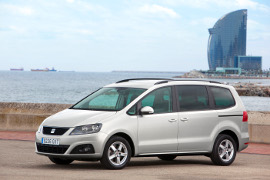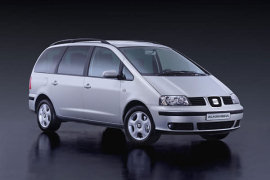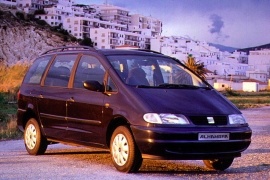SEAT Alhambra Models/Series Timeline, Specifications & Photos
First production year: 1996
Engines: Gasoline, Diesel
Body style: Van
Volkswagen's Group minivans built its first generation of minivans together with Ford, but for the second generation unveiled in 2010 relied only on its own resources.
SEAT Alhambra was one of the MPVs built by the German carmaker under the Spanish brand. While it kept the original idea, it showed a clear evolution in all of its aspects. From its design language to its underpinnings, it was a completely new vehicle, built on top of a Volkswagen platform.
Unlike its Volkswagen Sharan sibling, the Alhambra showed a sportier look. Its angular headlights were wide and gave an angry face to the minivan, and the sixteen vertical slats on the black grille offered an imposing presence on the road. The front fascia sported a wrapped-around bumper with a broad grille and two side-scoops for the headlights. From its side, the sloped windshield continued the steep hood. Unlike its predecessor, the second generation of the Alhambra featured sliding rear doors. At the back, the angular taillights were extended from the rear quarter panels to the wide tailgate.
Inside, the Alhambra offered room for seven with an option for integrated child seats in the middle row. At the front, the carmaker installed a wide dashboard with a tall center stack for the audio system and the bottom-mounted climate control unit. SEAT designers made an instrument panel with silver rings around the tachometer and speedometer, including the fuel and coolant-temperature gauges on their lower side.
Under the hood, SEAT carried over only the 2.0-liter turbo-diesel unit from the Alhambra's facelifted first generation, but the 1.4-liter TSI (turbocharged gasoline) and the 2.0-liter TSI were new. The Spanish carmaker provided up to 220 hp for its MPV, which proved that the angry look was not for nothing.
SEAT Alhambra 2.0L TDI 4x4 6MT AWD (140 HP)
SEAT Alhambra 2.0L TDI 6AT FWD (140 HP)
SEAT Alhambra 2.0L TDI 6AT FWD (170 HP)
SEAT Alhambra 2.0L TDI 6MT FWD (115 HP)
SEAT Alhambra 2.0L TDI 6MT FWD (140 HP)
SEAT Alhambra 2.0L TDI 6MT FWD (170 HP)
SEAT Alhambra 2.0L TDI CR 6AT FWD (184 HP) DSG
Volkswagen and Ford worked together to counteract the Eurovan alliance made between Fiat and PSA Group, and in 1995 they launched a range of minivans sold under three different badges.
While the Germans kept the most expensive and better-equipped vehicles, SEAT was in charge of attacking the budget-priced MPV market. It aimed directly at the rental companies and for those who asked for more from a minivan. The Seat Alhambra was a good bet since the Spanish brand was lower-priced than its siblings Volkswagen Sharan or Ford Galaxy.
SEAT introduced the facelifted Alhambra in 2000. It kept its brand image with the chromed S-badge at the front, surrounded by a body-colored bumper extension. Its grille with horizontal slats was spread between the redesigned headlights, which featured an angular styling and clear glass. Its steep hood was continued in the same line by the large windshield. The extended roof was slightly curved toward the end of the car, where a curved tailgate ended the vehicle. It was the transition design between the bio-design and new-edge design trend.
Inside, SEAT installed a seven-seat layout in a 2-3-2 configuration, with the second and third rows folding to increase the trunk's volume. Due to its high-mounted seating position, the first and second rows offered enough room for passengers, although the third row was cramped and suitable mostly for children or short adults. The redesigned instrument panel featured silver rings around the dials and red needles. A new infotainment unit with a navigation system became available for the entire range.
Under the hood, SEAT installed VW-sourced engines, either gasoline or turbo-diesel versions.
Apart from the French brands, other European carmakers didn't enjoy the same success on the minivan market, and Volkswagen tried to get a slice of the pie. But to develop a program only for its brand was very expensive. Ford was in the same position, so the two carmakers cut a deal by sharing the costs, and thus the badge-engineered siblings of Ford Galaxy, Volkswagen Sharan, and SEAT Alhambra took off. All three of them were built on the same assembly line in Spain.
Unlike the Galaxy or the Sharan, the SEAT was supposed to have a sportier look and to aim at younger customers, who needed a seven-seater for enjoying time out. Yet, there were slight differences between the vehicles. The Alhambra featured a different pair of headlights, which appeared to be slightly larger than those from its siblings. Also, the smiling grille split in half and adorned by a big, chromed SEAT badge was also a sign of recognition for the Spanish-branded MPV. The back of the car showed a clear distinction, thanks to the red strip that crossed the tailgate and uniting the taillights.
Inside, there was the same cabin layout with a five or seven-seat option. The car-like dashboard design, but with a taller center stack, surrounded the driver. Yet, the center console divided the front seats, so you couldn't easily cross the vehicle from left to right, like in many American minivans. Ford considered that this approach was more suitable for the European market.
Under the hood, the Alhambra was available with four Volkswagen engines: two turbodiesels and two gasoline-powered versions. For specific markets, two of them were available also with an automatic transmission.


